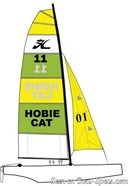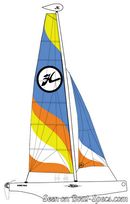Hobie Cat Max Easy
Sailboat specifications
The Hobie Cat Max is a 16’1” (4.9m) double handed sport/beach catamaran designed by Hobie Cat Europe (France). She was built since 2003 (and now discontinued) by Hobie Cat (United States). The Easy version displays the smallest rig and sail area available on this boat.
The Hobie Cat Max is as well listed, on Boat-Specs.com, in Race version (see all the versions compared).
The Hobie Cat Max is as well listed, on Boat-Specs.com, in Race version (see all the versions compared).
Hobie Cat Max's main features
- Model
- Hobie Cat Max
- Version
- Easy
- Hull type
- Catamaran
- Category
- Double handed sport/beach catamaran
- Sailboat builder
- Sailboat designer
- Country
- United States
- Construction
- GRP (glass reinforced polyester):
Sandwich foam fiberglass polyester - First built hull
- 2003
- Last built hull
- Discontinued
- Appendages
- Skegs : skeg on each hull
- Helm
- Single tiller
- Rudder
- Twin transom hung rudders
- Unsinkable
- No
- Trailerable
- Yes
- EC design categoryiThe CE design category indicates the ability to cope with certain weather conditions (the sailboat is designed for these conditions)
A: Wind < force 9, Waves < 10m
B: Wind < force 8, Waves < 8m
C: Wind < force 6, Waves < 4m
D: Wind < force 4, Waves < 0,5m - C
- Standard public price ex. VAT (indicative only)
- About10 600 €(2017)
Hobie Cat Max's main dimensions
- Hull length
- 16’ 1”4.9 m
- Waterline length
- 15’ 11”4.85 m
- Beam (width)
- 8’ 2”2.5 m
- Light displacement (MLC)
- 320 lb145 kg
- Capacity
- 529 lb240 kg
Hobie Cat Max's rig and sails
- Upwind sail area
- 147 ft²13.66 m²
- Downwind sail area
- 318 ft²29.57 m²
- Mainsail area
- 118 ft²11 m²
- Jib area
- 29 ft²2.66 m²
- Asymmetric spinnaker area
- 200 ft²18.57 m²
- IiFore triangle height (from mast foot to fore stay top attachment)
- 16’ 11”5.16 m
- PiMainsail hoist measurement (from tack to head)
- 24’ 5”7.43 m
- Rigging type
- Cat boat Marconi fractional
- Mast configuration
- Fore beam stepped mast
- Rotating spars
- Yes
- Number of levels of spreaders
- 1
- Spreaders angle
- Swept-back (diamond)
- Spars construction
- Aluminum mast and no boom
- Standing rigging
- 1x19 strand wire continuous
Hobie Cat Max's performances
- Crew
- 2
- Trapezes
- 2 set(s)
- Upwind sail area to displacementiThe ratio sail area to displacement is obtained by dividing the sail area by the boat's displaced volume to the power two-thirds.
The ratio sail area to displacement can be used to compare the relative sail plan of different sailboats no matter what their size.
Upwind: under 18 the ratio indicates a cruise oriented sailboat with limited performances especially in light wind, while over 25 it indicates a fast sailboat. - 533 ft²/T49.49 m²/T
- Downwind sail area to displacementiThe ratio sail area to displacement is obtained by dividing the sail area by the boat's displaced volume to the power two-thirds.
The ratio sail area to displacement can be used to compare the relative sail plan of different sailboats no matter what their size. - 1153 ft²/T107.14 m²/T
- Displacement-length ratio (DLR)iThe Displacement Length Ratio (DLR) is a figure that points out the boat's weight compared to its waterline length. The DLR is obtained by dividing the boat's displacement in tons by the cube of one one-hundredth of the waterline length (in feet).
The DLR can be used to compare the relative mass of different sailboats no matter what their length:
a DLR less than 180 is indicative of a really light sailboat (race boat made for planning), while a DLR greater than 300 is indicative of a heavy cruising sailboat. - 36
Hobie Cat Max's auxiliary engine
- Engine(s)
- No engine
Hobie Cat Max's accommodations and layout
- Cockpit
- No cockpit
Similar sailboats that may interest you:
Sailboats
First built hull
Hull length
1998
12’ 10”3.91 m
2002
16’ 6”5.04 m
2015
13’ 4”4.04 m
2014
16’ 1”4.9 m
2003
14’ 5”4.38 m
2004
14’ 10”4.5 m
1969
16’ 7”5.05 m
2002
17’ 2”5.25 m
1992
16’ 2”4.95 m
2003
16’ 1”4.9 m
1985
17’5.18 m
1998
17’ 2”5.25 m
1994
13’ 1”3.98 m
1993
15’4.56 m
1998
16’ 5”5 m






